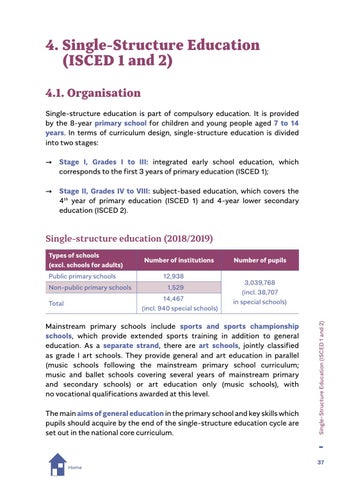4. Single-Structure Education (ISCED 1 and 2) 4.1. Organisation Single-structure education is part of compulsory education. It is provided by the 8-year primary school for children and young people aged 7 to 14 years. In terms of curriculum design, single-structure education is divided into two stages: → Stage I, Grades I to III: integrated early school education, which corresponds to the first 3 years of primary education (ISCED 1); → Stage II, Grades IV to VIII: subject-based education, which covers the 4th year of primary education (ISCED 1) and 4-year lower secondary education (ISCED 2).
Single-structure education (2018/2019)
Public primary schools Non-public primary schools
Number of institutions 12,938 1,529 14,467 (incl. 940 special schools)
Total
Number of pupils 3,039,768 (incl. 38,707 in special schools)
Mainstream primary schools include sports and sports championship schools, which provide extended sports training in addition to general education. As a separate strand, there are art schools, jointly classified as grade I art schools. They provide general and art education in parallel (music schools following the mainstream primary school curriculum; music and ballet schools covering several years of mainstream primary and secondary schools) or art education only (music schools), with no vocational qualifications awarded at this level. The main aims of general education in the primary school and key skills which pupils should acquire by the end of the single-structure education cycle are set out in the national core curriculum.
Home
Single-Structure Education (ISCED 1 and 2)
Types of schools (excl. schools for adults)
37

